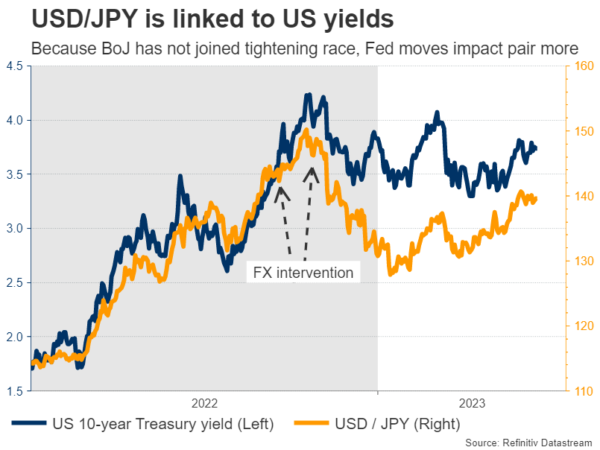Brighter outlook
Economic activity in Japan has picked up steam. Revised figures showed the economy grew by 2.7% in annualized terms in the first quarter of this year, and leading indicators such as business surveys suggest this momentum is likely to persist for some time.
On the inflation front, the situation seems even more promising. Inflation is running near its fastest pace in three decades and the spring wage negotiations resulted in serious pay rises for workers, helping to fuel optimism that inflationary forces are becoming more entrenched.
Yet, BoJ officials are not convinced. Haunted by decades of deflation and mistaken decisions to tighten policy prematurely in previous cycles, the BoJ has committed to ‘play it slow’ this time. The Bank’s forecasts suggest inflation is going to cool off later this year and Governor Ueda has warned the recent victories on the wage front might not be sustained.
In addition, the BoJ is concerned about a global slowdown that inflicts collateral damage on Japan’s export-heavy economy. As a result, the central bank has made it crystal clear that it won’t tighten policy until it is convinced inflation will remain sustainably above 2%.
On hold, for now
With the likelihood of an immediate policy shift appearing low and this being a meeting without updated economic forecasts, the focus will be mostly on any changes in the language. Specifically, will the BoJ strike a more optimistic tone on inflation, setting the stage for an upgrade of its inflation forecasts at the next meeting in July?
Forecasts are extremely important for the central bank. The way that BoJ officials will ultimately determine whether inflation will remain ‘sustainably’ above 2% is by whether their inflation forecasts for the next 2-3 years say it will.
We are pretty close to this stage. All that remains is for the 2025 forecasts to be revised higher, which could very well happen in July. That would be the signal that further policy tightening is imminent, elevating the importance of the July meeting.
Yen outlook
In the markets, in case the BoJ does nothing once again, that would argue for a minor negative reaction in the yen as those looking for immediate tightening are left disappointed. Taking a technical look at dollar/yen, the first barrier to the upside might be the latest local high near 141.00.
On the flipside, a surprisingly hawkish tone that refuels market bets for near-term tightening could breathe some life back into the devastated currency. In this case, the focus would shift towards the 138.00 zone in dollar/yen, which roughly encompasses the 200-day moving average too, currently at 137.30.
Aside from BoJ policy, the other two elements that will influence the yen’s trajectory moving forward are the actions of other major central banks and global risk sentiment. With the Fed and the ECB likely to hit the ‘pause’ button this summer just as the BoJ considers tighter policy, the environment seems favorable for the yen.
If such a shift in central bank policies coincides with a selloff in stock markets that fuels safe-haven demand for the Japanese currency, that could mark the beginning of a healthy recovery in the yen. Alas, this is probably a story for July or beyond.
















